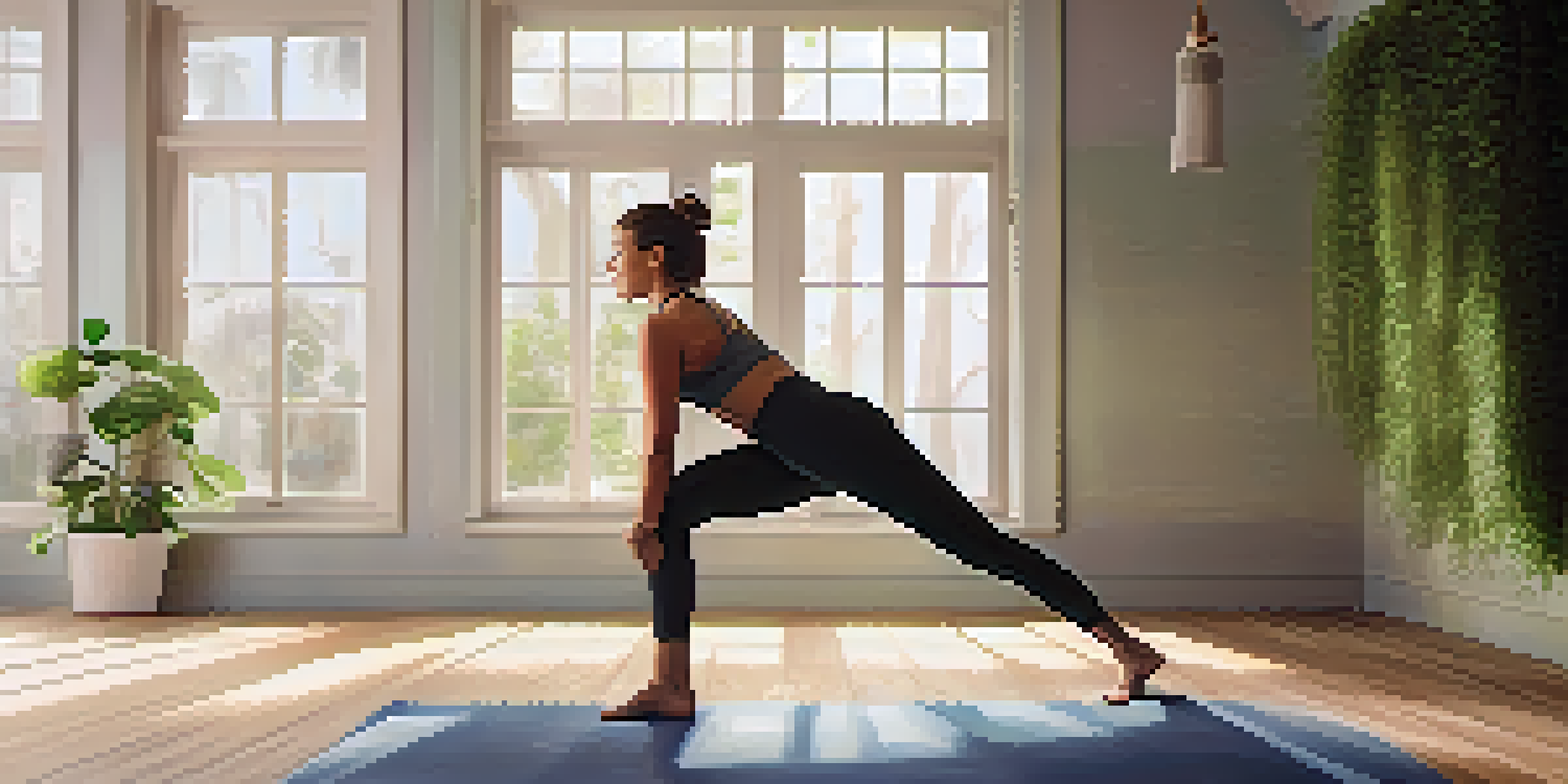Top 5 Yoga Techniques for Increasing Flexibility Quickly

Understanding the Importance of Flexibility in Yoga
Flexibility plays a crucial role in yoga, allowing for better movement and posture. It enhances your ability to perform various poses, making your practice more enjoyable and effective. Moreover, improved flexibility can lead to reduced risk of injury, as your muscles and joints become more resilient.
Flexibility is not just about the ability to bend; it's about the ability to adapt and flow with life.
Many people think flexibility is just about being able to touch your toes, but it's so much more than that. It affects your overall strength and balance, which are essential for maintaining a well-rounded yoga practice. When your body is flexible, you can better connect with your breath and deepen your stretches.
Incorporating flexibility-focused techniques into your routine can elevate your practice and promote relaxation. As you become more flexible, you may also notice a boost in your overall well-being, both physically and mentally. So, let's explore some effective yoga techniques that can help you increase your flexibility quickly.
1. Sun Salutations to Warm Up Your Body
Sun Salutations, or Surya Namaskar, are a fantastic way to start any yoga session. This sequence of poses warms up your entire body, promoting blood flow and flexibility. By practicing Sun Salutations, you engage multiple muscle groups, making them ideal for preparing your body for deeper stretches.

As you move through each pose, focus on your breath and maintain a steady rhythm. This will not only enhance your flexibility but also help you develop a mind-body connection essential for yoga practice. The continuous flow of movement encourages relaxation and sets a positive tone for your session.
Flexibility Enhances Yoga Practice
Improved flexibility allows for better movement, posture, and a reduced risk of injury in yoga.
Incorporate several rounds of Sun Salutations into your warm-up routine, gradually increasing your speed and intensity. This technique lays a solid foundation for your flexibility journey, making it easier to tackle more challenging poses later on. Plus, it's a great way to build strength and endurance.
2. Deep Lunges for Hip Flexibility
Deep lunges are incredibly effective for improving flexibility in your hips and quadriceps. This pose allows you to open up your hips, which can often be tight due to prolonged sitting or inactivity. By practicing deep lunges regularly, you'll notice a significant increase in your range of motion.
Yoga is the journey of the self, through the self, to the self.
To perform a deep lunge, step one foot forward and lower your back knee to the ground. Ensure your front knee is directly above your ankle, and engage your core for stability. Hold the pose for several breaths, allowing your hips to sink deeper with each exhale.
You can also modify the deep lunge by using props like blocks or bolsters for added support. This technique not only enhances hip flexibility but also helps build strength in your legs. Over time, you'll feel more comfortable in various yoga poses that require open hips.
3. Pigeon Pose for Deep Hip Opening
Pigeon Pose, or Eka Pada Rajakapotasana, is a favorite among yogis for its ability to deeply open the hips and stretch the glutes. It's an excellent way to release tension accumulated in the hip area, which can contribute to increased flexibility. The beauty of this pose lies in its ability to target multiple muscle groups at once.
To get into Pigeon Pose, start in a tabletop position and bring one knee forward, placing it behind your wrist. Extend the opposite leg straight back, keeping your hips square to the floor. As you settle into the pose, focus on breathing deeply and relaxing into the stretch.
Consistent Practice is Key
Incorporating flexibility-focused techniques regularly is essential for building strength and achieving lasting results.
Hold this pose for several breaths, and consider incorporating variations like forward bends or twists to deepen the stretch. Practicing Pigeon Pose regularly can lead to significant improvements in hip flexibility, making it easier to transition into other poses with grace.
4. Seated Forward Bend for Hamstring Stretching
The Seated Forward Bend, or Paschimottanasana, is an excellent pose for stretching the hamstrings and lower back. This pose not only enhances flexibility but also promotes relaxation and calmness, making it a perfect addition to any yoga session. As you bend forward, you'll feel the stretch along your spine and hamstrings.
To perform this pose, sit with your legs extended in front of you and inhale deeply. As you exhale, hinge at your hips and reach for your feet or shins, keeping your spine straight. Remember, it's essential to listen to your body and avoid forcing the stretch.
Holding the Seated Forward Bend for several breaths allows your body to gradually relax deeper into the stretch. Over time, you'll notice increased flexibility in your hamstrings, which can enhance your overall yoga practice and daily movements.
5. Butterfly Pose for Inner Thigh Flexibility
Butterfly Pose, or Baddha Konasana, is a gentle yet effective way to open up the inner thighs and hips. This pose is particularly beneficial for those who spend long hours sitting, as it helps release tightness in the groin area. The simplicity of Butterfly Pose makes it accessible for yogis of all levels.
To practice this pose, sit on the floor and bring the soles of your feet together, letting your knees fall out to the sides. Hold your feet with your hands, and gently press your elbows into your thighs to deepen the stretch. Focus on maintaining a straight back as you breathe deeply.
Mind-Body Connection Matters
Focusing on your breath while practicing poses deepens the mind-body connection, enhancing your overall yoga experience.
As you hold the Butterfly Pose, you may find it helpful to rock gently side to side, allowing your hips to open up gradually. With regular practice, you'll experience improved flexibility in your inner thighs, which can enhance your performance in other yoga poses.
Tips for Maximizing Your Flexibility Journey
While practicing these yoga techniques, consistency is key. Aim to incorporate flexibility-focused sessions into your weekly routine, even if it's just for a few minutes each day. This regular practice will help you build strength and flexibility over time, leading to lasting results.
Listening to your body is crucial; never push yourself beyond your limits. Flexibility is a gradual process, and it's important to respect where your body is at each moment. Consider pairing your yoga practice with complementary activities, such as foam rolling or gentle stretching, to further enhance flexibility.

Lastly, remember to enjoy the journey! Celebrate the small victories and progress you make along the way. With patience and dedication, you'll not only improve your flexibility but also cultivate a deeper connection with your body and mind.